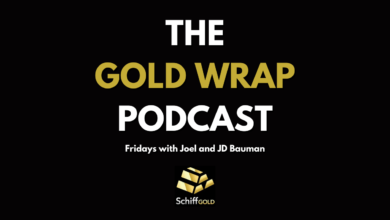Debt Chickens Are Coming Home to Roost

After the Federal Reserve incentivized borrowing with more than a decade of artificially low interest rates and easy money, the debt chickens are coming home to roost.
Last week, Fitch Ratings downgraded the US’s long-term credit rating from AAA to AA+, and on Monday, Moody’s cut the credit rating of 10 small and midsize banks.
Moody’s also placed six large banks on review for potential downgrades and revised 11 more banks from a stable outlook to a negative outlook.
This indicates that the financial crisis continues to bubble under the surface.
The Moody’s report said funding risks and weaker profitability in a higher interest rate environment are squeezing the entire banking sector’s credit strength.
Many banks’ second-quarter results showed growing profitability pressures that will reduce their ability to generate internal capital.”
Moody’s said a “mild recession” in early 2024 could put further stress on banks and problems in the commercial real estate (CRE) sector could spill over into the financial sector.
Elevated CRE exposures are a key risk given sustained high interest rates, structural declines in office demand due to remote work, and a reduction in the availability of CRE credit.”
Notably, Moody’s only predicts a mild recession. But given that interest rates are at a level not seen prior to the Great Recession and there is far more debt and malinvestment in the economy now than there was then, it remains unclear why we should expect a more moderate downturn than we experienced in ’08.
The Moody’s report also mentioned the “sizable unrealized economic losses” in many banks’ bond portfolios, saying they could cause investors to lose confidence. This is exactly what sank Silicon Valley Bank, Signature Bank and First Republic Bank.
The Federal Reserve managed to paper over the banking crisis with a bailout program. But the most recent Moody’s bank rating downgrades reveal the problem wasn’t solved.
“As you look ahead, it doesn’t feel like the pressure from interest rates being higher and overall monetary policy tightening is close to abating,” Moody’s associate managing director Jill Cetina said.
We’ve seen funding strains in the banking sector. The interest rate risk, I think, was something that the US banking sector was not prepared particularly well for, and because of that, we have some challenges at certain banks.”
Here is the list of downgraded banks:
- Commerce Bancshares
- BOK Financial Corporation
- M&T Bank Corporation
- Old National Bancorp
- Prosperity Bancshares
- Amarillo National Bancorp
- Webster Financial Corporation
- Fulton Financial Corporation
- Pinnacle Financial Partners
- Associated Banc-Corp
These banks were put on review for potential downgrade:
- Bank of New York Mellon Corporation
- Northern Trust Corporation
- State Street Corporation
- Cullen/Frost Bankers
- Truist Financial Corporation
- U.S. Bancorp
These banks had their outlooks shifted from stable to negative:
- PNC Financial Services Group
- Capital One Financial Corporation
- Citizens Financial Group
- Fifth Third Bancorp
- Huntington Bancshares
- Regions Financial Corporation
- Cadence Bank
- F.N.B. Corporation
- Simmons First National Corporation
- Ally Financial
- Bank OZK
The Big Picture
Debt problems in the banking sector are just a small part of a massive debt bubble blown up due to a decade of artificially low-interest rates in the wake of the Great Recession and a tidal wave of easy money during the pandemic.
Most people blame the shakiness in the financial sector and the broader economy on recent interest rate hikes, but the real problem started years ago.
After the Great Recession, Federal Reserve policy intentionally incentivized borrowing to “stimulate” the economy. But this monetary inflation inevitably led to price inflation. That forced the Fed to raise interest rates. The central bank managed to cool price inflation (for now), but it also threatens to pop the debt bubble.
In other words, high interest rates are only a problem today because the Fed incentivized so much borrowing yesterday. What the Fed giveth, the Fed taketh away, and it was inevitable that these debt chickens would come home to roost.
Banking isn’t the only sector being drug down by debt.
The national debt now stands at $32.6 trillion. The US government has borrowed more than $1 trillion since the debt ceiling deal. The interest payment on all of the debt is set to rise at an alarming and unsustainable rate.
Corporations are levered to the hilt with the number of corporate defaults already larger than the total in 2022.
And American consumers are also buried under a mountain of debt. Credit card debt topped $1 trillion for the first time ever in the second quarter of this year. More concerning is the fact that consumers may be close to reaching their borrowing limit. After increasing at a frenetic pace for more than a year, revolving credit suddenly plunged in June.
With interest rates at levels not seen since 2006, it is inevitable that these debt bubbles will pop. The recent credit downgrades reflect this reality.
We saw what that looks like in 2008 and we know it won’t be pretty.
Call 1-888-GOLD-160 and speak with a Precious Metals Specialist today!
Buka akaun dagangan patuh syariah anda di Weltrade.
Source link





